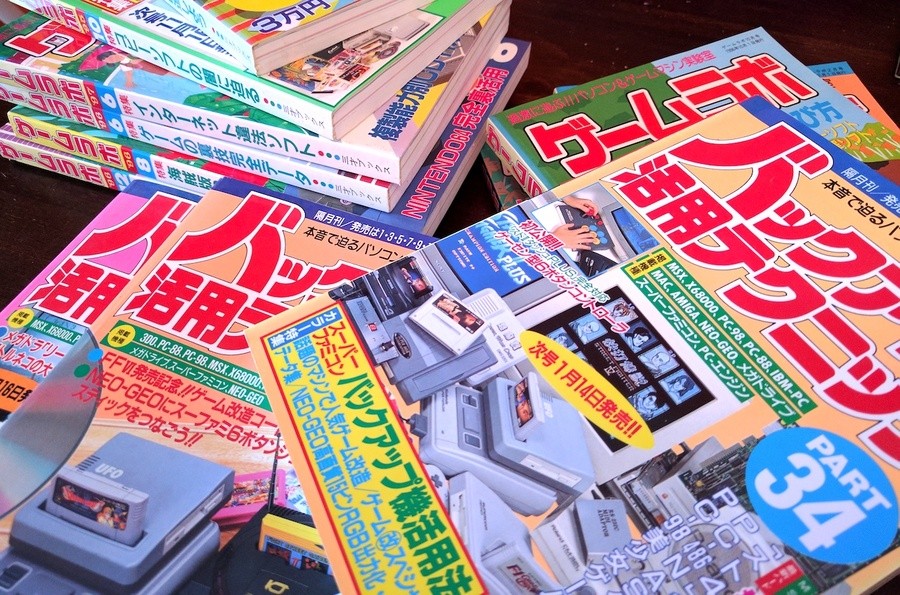
All the video game magazines you and I grew up with were crap. We were robbed. Dealt a poor hand. Okay, that might be a little extreme, they were not crap per se - we just never had it as good as our friends in Japan. Sure, many a mag tried and came very close - Super Play immediately springs to mind with its wonderful pro-NTSC-J angle - but I feel that we in the West really did miss out on the super juicy good stuff. The kind of stuff that dreams, quite literally, were made of.
Had Backup Technique and Game Lab found their way over to Western shores, localized, I strongly believe they could quite easily have changed how many folk this side of the globe would go on to hack, crack, investigate and explore computer and console hardware and software. Sansai Books published Backup Technique (バックアップ括用テクニック) which made its debut on Japanese newsagent shelves around May 1991 and ran for 38 issues. Initially focusing mainly on the Nintendo Famicom, Backup Technique would evolve to cover, quite literally, every console and computer currently available. From PC-8801 to MSX, to Game & Watch to Bandai Playdia and beyond. You name it, this little magazine covered it.
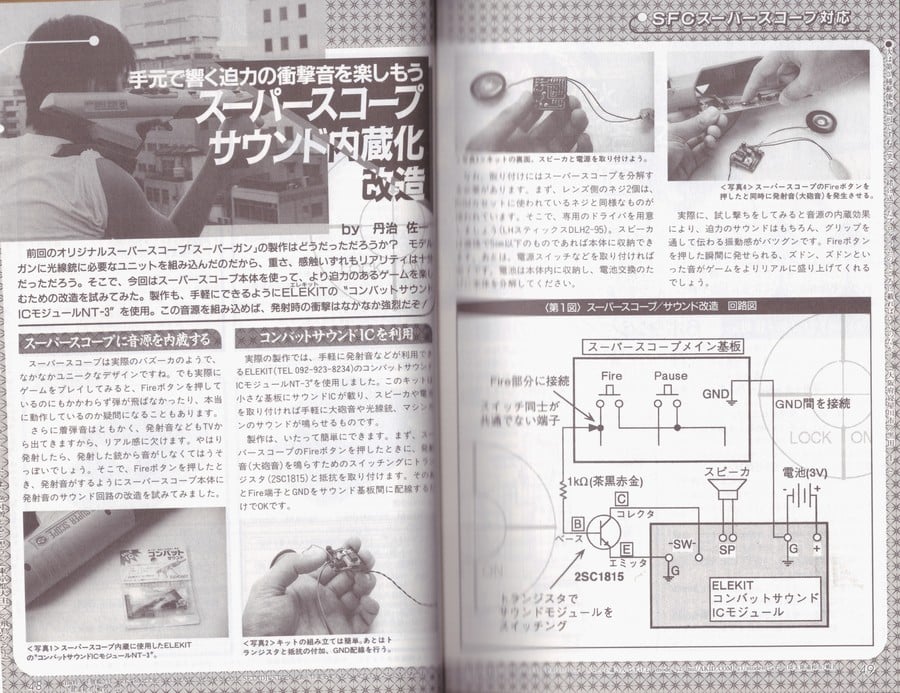

'Little magazine' is an understatement and an insult. Every month readers would receive a, thick, A5 format, 200-plus page hunk of pure, invaluable gold. For Backup Technique was not your average magazine. The Japanese were feasting, nay, gorging themselves ragged on the hottest in computer and console modifications, chip swaps, programming hacks, scripts, GSM tinkering, wiring diagrams and so much more I'd need to change my trousers several times over just during the process of listing them for you.
Meanwhile, we in the West were busying ourselves scouring for mere scraps of import news buried deep amongst the latest game reviews, screenshots of Axelay, mugshots of the late Sir Patrick Moore and mailed-in drawings of Ranma 1/2 characters that looked like a cross between Arthur Scargill and an absolutely hammered Ted Nugent on a camping holiday somewhere between Luton and Stevenage lovingly recreated with the finest in supermarket brand felt tip. But I'm not bitter! Honest.
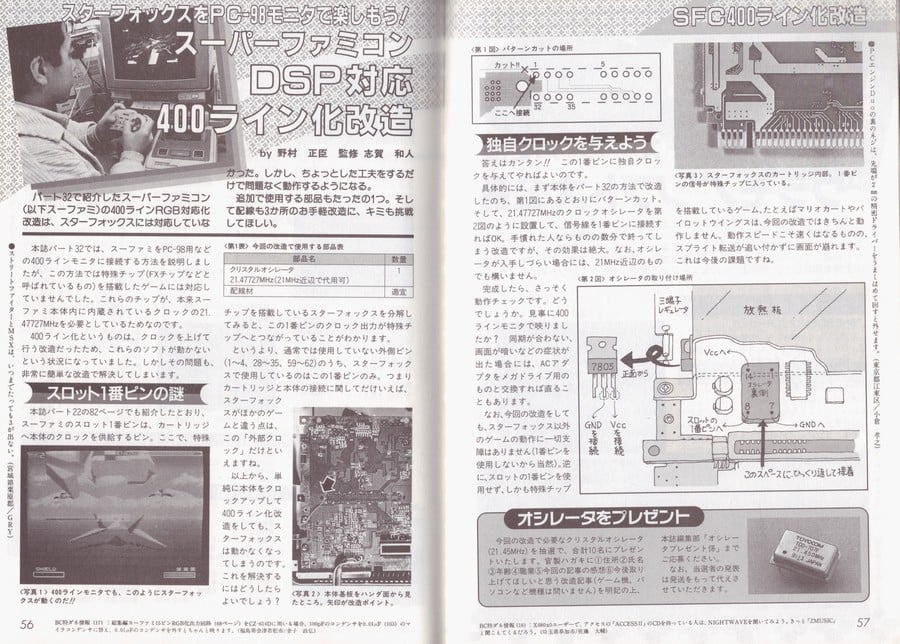

Part 38, which arrived in July 1994, would be the last issue of Backup Technique before it was rebranded and relaunched as Game Lab (ゲームラボ). Rumour has it that the magazine was retitled so as to not attract unwanted attention from the authorities. Though I have yet to find 100% confirmed proof of this it does appear to add up when you take into consideration the magazine dipped a toe or two into the waters of hacking and phreaking years before those concepts were even on the radar of mainstream western gamers.
Game Lab would pick up where Backup Technique left off and continued to produce a stellar monthly read. Having amassed a small collection of 50+ volumes of both titles in my personal collection ranging from 1993 up until 1999, it is great to get such a lengthy overview of how the magazine evolved as consoles and computers became ever more sophisticated and eventually moved toward exchange of information online. These magazines provide some degree of historical significance in that aspect. Yet, even today, you can pick up a volume, flip through and almost instantly find a page with something unique. A program, a modification, a diagram, a photo. Something you've never seen the likes of before.
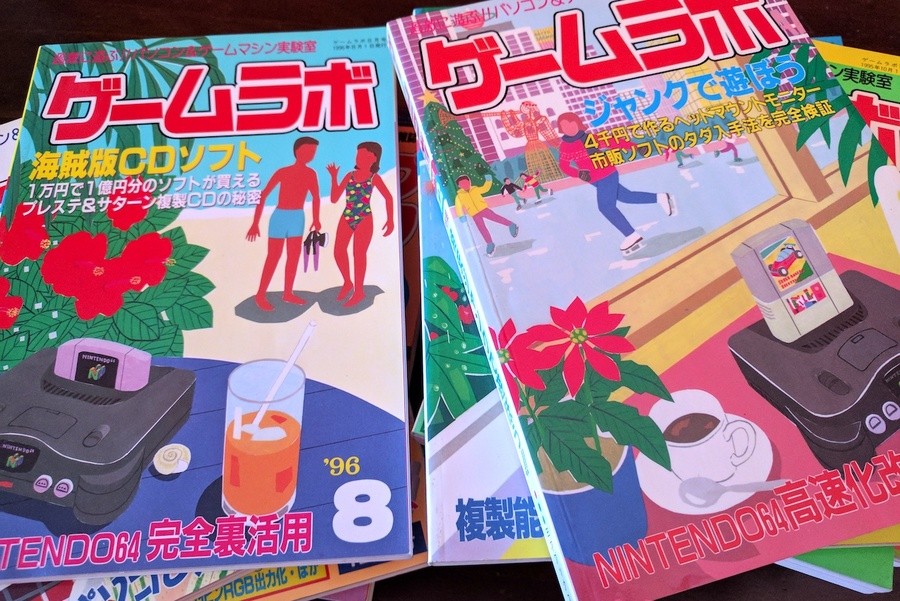
For example, one issue of Backup Technique contains photos and schematics to add composite inputs to a Nintendo Virtual Boy which is in turn connected to a camcorder presumably as some sort of portable home theatre. Keep firmly in mind that this is going on decades before your Google Glass and PlayStation VR thingamyjigs!
A lot of focus would be placed on duplicating and dumping games. Attention in particular would be paid to cartridge systems such as the Game Boy, Super Famicom and Nintendo 64. Can't afford to buy a copier device? No problem, build your own for a fraction of the price! One particular issue of Game Lab contained a magnificent feature on creating your own Super Famicom reader/writer device. Build instructions, components lists for Akihabara shopping trips and so on were provided including pages upon pages of typed-up programs to get you off and running. Pales in comparison to Western mags with their PEEK, POKE and BASIC typo fiestas, doesn't it?
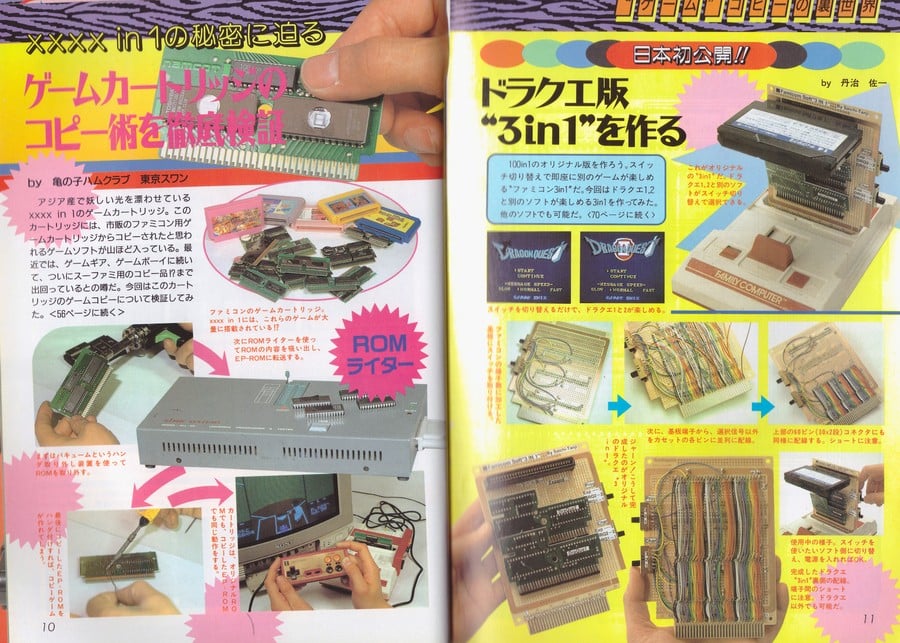
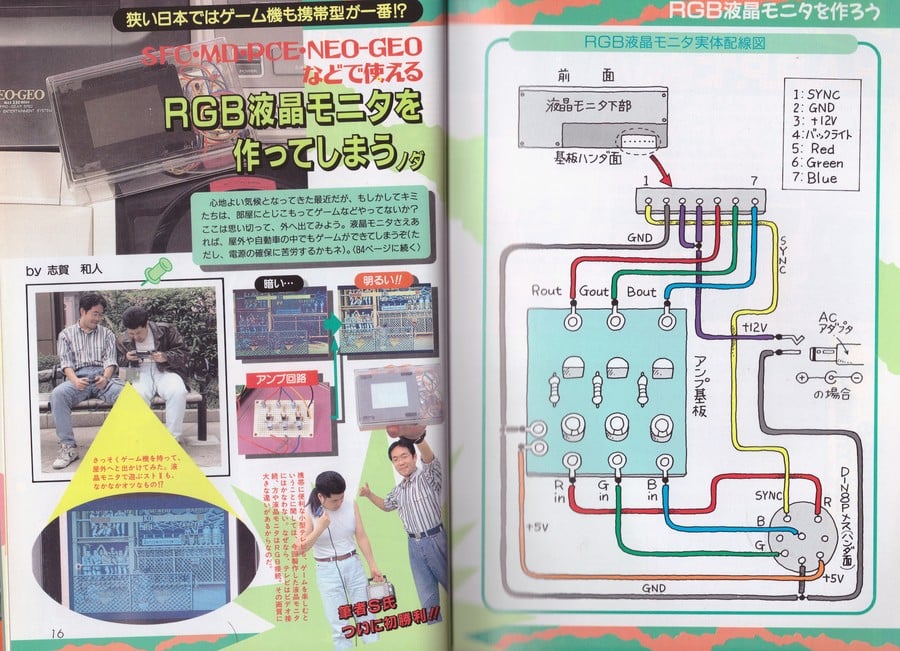
It gets better. Think you've seen every modification possible for your favourite retro console or computer? Think again! So far I've seen detailed articles and full programs for a Capcom Q Sound player. Full programs (presented over a couple of issues) to make your own Sega Saturn BASIC games. Neo Geo and Super FX chip 400 line modifications. A Super Famicom Super Scope sound modification complete with diagrams. A Super Famicom UHF signal transmitter, again complete with schematics and instructions. Some sort of bizarre GSM-related Sega Saturn credit card reader (an equally bizarre PlayStation memory card and GSM phone tutorial was featured in the same issue). The list is quite literally almost endless.
So what happened? Where is this fabled bible of gaming greatness today? Game Lab is still in print, still under the Sansai Books publishing house. Yet the magazine is virtually unrecognizable today, with no real trace of its hacking legacy to be found. Even if you delve deep into the most obscure online research you won't dig up that much.
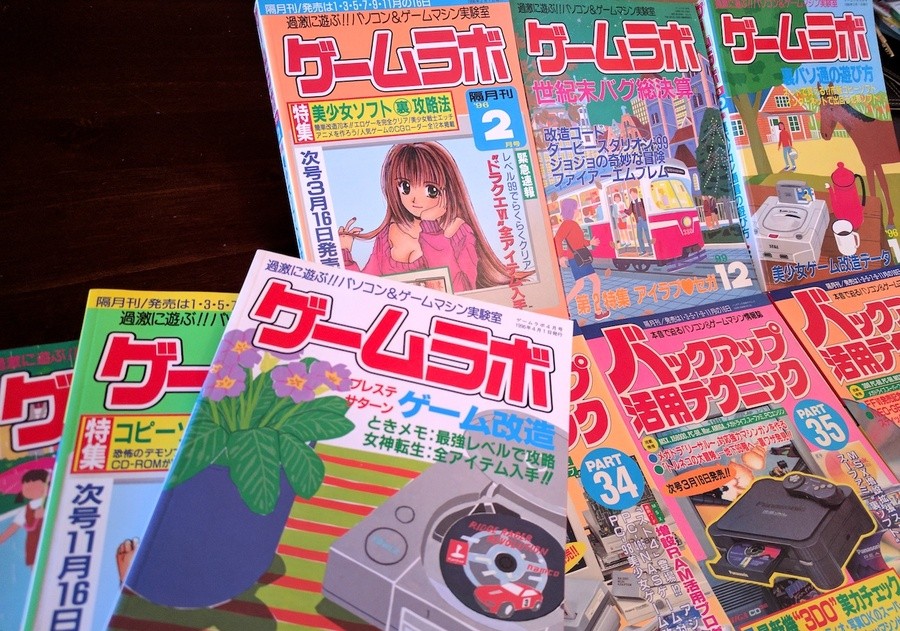
As time marched on and technology evolved rapidly, computers and consoles became less accessible and therefore tougher nuts to crack. When all you have to write about is using Linux on a PlayStation 3 and the death of the Sega Dreamcast you really need to fill your pages up with something else to fulfill your criteria. The staff at Game Lab decided the best path to go down would be that of porn, dating simulators and other such seedy smut. Gone were the game reviews, the schematics, the wild manga strips and obsessive chatter about diodes, capacitors and crystal oscillators. Dismissed were the wild and crazy modifications that brought about whole new ways of thinking about using and interacting with your computer or console. Forgotten were the pages upon pages of detailed machine code, complex programs, hacks, tips and cracks. All of this was phased out to be replaced by cartoon boobs, pixelated willies, slimy tentacles and schematics for sex toys. Urgh.
It is highly likely in this modern day of tough copyright laws, restrictive DRM, lawsuits, general big business and corporate greed that we will never again see the likes of Backup Technique and Game Lab. Certainly, information of this ilk can be found and made readily available online. But nobody would dare put into print the kind of information you could find readily available betwixt those glorious pages that for decades have been kept hidden away from inquisitive eyes outside of Japan.
Ian Cortina is a 37 year old curiosity from the UK and Catalunya. He likes computing, attempting to solve complex problems and anything analog. He made a 'zine once in 2013 and sold over 500 copies though he's not sure if that qualifies him as a published author. Probably not. You can check out his site here.





Comments 70
Maybe this writer should cut the crap (seriously, there are better words you can use).
RetroGamer Magazine (UK, which is still going), would like a word with you.
That magazine sounds fantastic, would have loved something similar in the UK...
Okay. Wow. Those are some Beefy Magazines.
Haha, this is niiiiche, but really well written and surprisingly interesting. I like it when we get treated to longform articles on stuff that doesn't really have any trendy current news connections.
I'm still mourning the passing of ONM though (yes, after all these years), so the opening lines sting a little. Nothing we'll ever replace you, my sweet prince.
Sorry but you're wrong...The Edge magazine was and still is waaay better than anything from Japan.
The magazines I grew up reading were enough - when I could sit still long enough.
These magazines look pretty cool but as a kid I loved mean machines, super play and Total! - in fact I still have the first few issues of total and super play stashed away in my loft
While Backup Technique looks like it was an excellent magazine, I don't follow the argument of this article. Western magazines primarily provided mainstream, wide coverage of gaming or a particular system; this focuses on the niche area of hacking - they're completely different things.
Super Play was and always will be the best gaming magazine in the UK, if not the world.
Those magazine looks interesting and definitely different, their counterpart over here surely lacked the same care on the tech side (or maybe as a kid I didn't read articles about chips and such, that may be the case too XD).
Anyway I'm just glad gaming magazine were published even here in Italy, I would have never discovered the Zelda franchise as a kid without the legendary NRU X3
True story,when I was 15,a couple of weeks before I was due to sit my exams I got a bus down the high street specifically to pick up the new issue of "SEGA Magazine".I quickly bought it and got back on the same bus that took me down.I was so engrossed in the mag that I continued to read it as I left the bus.So engrossed that I never lifted my head from it as I walked directly behind the bus I just got off and across a main road where I got smacked by a car and sent flying into my mates hedge.Luckily I hit the side of the car, a split second earlier and I would have been smacked head on.It was around 25 years ago but I remember it vividly.The mag survived,I've still got it in fact along with a huge scar on my knee.
Maybe write an article on magazine we actually read? Last time I checked Nintendo life wasnt a japanese website so most of us don't know the language.
Ah... so Nostalgic.
Used to be adore those kinds of books.
But I don't need newest Game Magazine anymore. I know those magazine will have Tons of NSFW games that I really hate most.
So, I rely on this website for just Nintendo only games.
No they were not.
Computer and Video Games, Mean Machines, Super Play, MAXIMUM, EDGE . . . all say hello.
But, I still would have liked a mag that showed me how to actually get inside and tinker with these consoles--not that I would ever be in a position to really do so.
Well, the Japanese have more technically advanced requirements for their little ones than Westerners do (especially Americans), so I suppose this would be kid's stuff for them!
However, there was a gaming magazine in the US which was categorically in a league of it's own: Next Generation magazine. It had all the tech specs that people debate over so much these days. It discussed the design aspects, technical tricks, and philosophies of the developers. It discussed the economic aspects of the industry at a level of depth few other magazines of the time delved into. It was intended for industry insiders, so it was obviously more adult-oriented than most gaming magazines. The only thing going against it was that it wasn't as fun for a kid to read. (Although I do find the articles fascinating as an adult!)
I didn't have the wherewithal to understand everything back then, so I unfortunately only have one issue of Next Gen mag, which is the Super Mario 64/N64 release issue. I mostly only understood the Gamepro's, Tips & Tricks, EGM's, PSM's, Nintendo Power's, etc at that time... I missed out on an excellent magazine series. At some point, I'd like to collect them for an archive... And I already have a pretty substantial archive of the most important bits from decades of various magazines!
So yes, these technically oriented Japanese magazines look cool, but do they have heart? There's a point where one should balance human communication with the technology. Otherwise, you will only understand the technology, and not the people who created it.
Absolute nonsense, the UK had some fantastic magazines and I still have a collection of my favourites that I don't intend to part with!
These look cool, but I very much doubt any typical gamer in the U.K. at the time would understand any of it. I'm currently reading Super Play from the first issue and the number of questions about 'PAL' and 'SCART' is hilarious, really shows a different age where knowledge about technology was extrememly specialised. Even the writers weren't much more clued up!
Computer and video games.
@GravyThief At least its much simpiler now with hdmi 1.2 1.4, 4k, hdr 3d (add around another 50 to list)
& what ever Tv makers dream up next week try sell is another no wonder Toshiba is Technically bust at the moment
Looks complicated..
@BakaKnight woah, don't get me started on the sweet, sweet NRU! So many fond memories...
I'm still bitter that it doesn't exist anymore, and sometimes I find myself wondering how it would look now and how they'd approach new games and systems.
I still have all my issues sitting in my bedroom, from 6 all the way up to the last one (153 I think), minus 7.
On topic: well, it's sad to read such clickbait-y, Zergnet-like headers on NL. It doens't detract from the content or te quality of the article, but I hope it doesn't become a trend.
But do any of them have Mean yob Julian Rignall or a certain Charlie Brooker?
No. No they do not. 😉
This is a very literal article.
I grew up with subscriptions to Nintendo Power and Electronic Gaming Monthly (EGM). I absolutely loved those magazines. As a kid I couldn't care any less for the inner workings of my consoles and games. I was just all about the games. Games are what ultimately made me choose to become a programmer however.
In the 6th image from the top, what is that portable console on the left? It looks similar in shape to a Nomad, but isn't. Button colors are different and there looks to be 3 admin buttons. I collect portables, and I'm thinking I may have found my next target. I just don't know what console family that is in.
EDIT: I know Sega also had the aptly named "Computer Video Game" SG-1000. But that page doesn't look related to that at all. And I certainly never heard of a portable system.
I was a long term subscriber to Total and really miss Steve Jarret and Andy Dyer's reviews. I still have a few of these at home where they did the full collectible walkthroughs of Zelda a Link to the Past and Super Metroid. I would pore through these guides, gamepad in hand.
The same was and it true for music magazines in the U.S. The music magazines in the states fail when compared to magazines in the U.K. and Japan, with Japan leading the pack on occasion for being the best. Ok, back to listening to Baby Metal and Bang Dream!
Fun to look at now, but I'm glad this stuff didn't make it west when I was a kid. I probably would've tried some of it out and borked my consoles!
@PlywoodStick "technically advanced requirements"
I don't know, I've always thought that, but even here aren't the kiddies doing calculus by 4th grade these days or some such? I thought they learned calculus in elementary, quantum mechanics in middle school, and unicorn theory in HS, but are closed entirely out of 19th & 20th century history and told it did not happen?
"There's a point where one should balance human communication with the technology. Otherwise, you will only understand the technology, and not the people who created it."
That right there is why Nintendo has has what Xony don't.
@Nintendo_Alski So nice to hear someone mention Total! Magazine!!
'Super' in Italy was perfect (still have some numbers... from 1995/1997, etc.), at least before they shifted from Nintendo to Sony.
I would have asked nothing more than that.
Can't say seeing these makes me feel like I missed out. EGM and Nintendo Power (and Gamepro and Tips and Tricks to a lesser extent) were enough for me.
I grew up with Nintendo Power here in the states. I miss it.
C&VG with Julian "Jazz" Rignall as editor says hi!
Official Nintendo Magazine is not rubbish, and no Japanese mag will ever replace it as my favourite game magazine of all time, whatever anyone says!
There are and were tons of home hardware hacking magazines around. It's just not geared towards greedy people who just want to copy for free what others made. I think that is a good development in the readers of similar magazines that they no longer learn to hack for such reasons. I don't see why it's better to learn hacking for copying other people's work without their blessing, instead of to create something new of value oneself.
@G-Boy Got there before I could comment it, but let me wholeheartedly second that!
I loved 80s/90s US mags, especially Nintendo Power and EGM. Not sure I'd call them junk because I'm an adult.
@metalgario it was so good wasnt it!? I remember wishing I had a nes at the time and being blown away when they announced the super nes lol! They are probably worth a few quid now as I've kept them pretty mint but don't ever want to part with them. Rip Total! Magazine. I also miss ONM of course too, their free gifts were so good
Harsh. A lot of UK magazines were magic and still are today (you can find PDFs of a lot of them online). 1989-1992 CVG, Mean Machines (before the split), Super Play and the follow on from that which was Futures N64 magazine, Edge, the short-lived Maximum, Amiga Power (in its later irreverent years) and the ongoing Retro Gamer are/were up there with anything.
Crash
Zzap!64
Edge
Super Play / N64 Magazine / NGC / NGamer
Nintendo Power
Nice article! More articles about gaming magazines, please.
I'm weird, but every since going to Japan to see my pen pal in 8th grade, I always felt that what we were cheated out of the most was magazines. I grew up in the 90s and I barely had any time before magazines went out of style. Seeing their huge weeklies for so cheap was an insult to our magazines
Gaming mag articles are kinda cool. No objections. Reviews on games is even cooler. Waiting for about a hundred reviews of eshop games for 3ds.
Nah, I loved the humor of N64 Magazine to bits from then all the way up to the last Nintendo Gamer issue.
Sure Japan always has it better but you can't take away those childhood memories of reading about N64 games and getting a good laugh at the same time.
@Angelic_Lapras_King
N64 magazine was great. For some reason their review of Mario Kart 64 always sticks in my head. Think it was Jonathan Davies, who was always excellent.
Anybody wanting to a digital flick through some classic games mags should direct themselves to....
http://www.oldgamemags.com/index/#N
https://www.retromags.com/magazines/uk/n64/
https://archive.org/details/gamemagazines
What are all those cool consoles Im seeing in the 6th picture?
@datamonkey CVG loses points for basically spoiling the whole of resident evil 2 in the months leading up to its release, to the point I did the Zombie Forest trick on my first run through the OPM demo.
The greatest games magazine of the current era is EDGE. They even had Gran Turismo 2 before the Japanese press!
The greatest games magazine of all time is channel 4's old Digitiser service on teletext, especially the Mr. Biffo era. Daily updates before the internet! Just stay out of Mr. T's bins.
The greatest print magazine of all time was future publishing's ARCADE magazine. The feature I remember most was the 'games night' feature which rated 4-player games on their post-pub entertainment value. Had a lot of good nights off the back of that.
They also have away the OST to Wip3out (which I still have) and Game Over by David Sheff (which I also still have)
Whilst I think this is a good read on a magazine I didn't know about, I don't think it's necessary to compare them to the western magazines and call other mags crap in the process. It sounds like it was still a different type of audience.
@Angelic_Lapras_King @electrolite77 I'm with you both on N64 Magazine (which of course followed Super Play) and its follow-ons. They managed to strike a good balance between good journalism but also not taking it all too seriously. I loved the fact they had dedicated joke pages, and even joke competitions such of Lex Luthor's Solve My Maze.
@roadrunner343 Probably one of many bootleg Famicoms. It's called "Super Boy" according to the text, though I'm sure it's unrelated to the Hyperkin SNES clone. That whole page looks to be about bootleg consoles.
@KingMike Awesome, thanks for the response. I'm not really interested in bootlegs, so I guess that's why I didn't recognize it. I thought it was some obscure PC Engine or something. I should have known it was a bootleg I suppose, given the cartridge and the console sitting right next to it. Regardless, many thanks for setting my mind at ease =) Don't think I can afford anymore obscure PC Engine stuff.
Cool article. What a beefy magazine, though some of the tech and spec stuff would have been over my head as a kid when this pub ran. I was in from issue one of Nintendo Power through most of its first five years. I read each issue so many times that they were usually in pieces or taped together by the time the new issue arrived. I just picked up what appears to be the entire run of NP through the N64 era. I haven't sorted through all of them yet, but I've already come across the big OOT issue and a fold out "coming soon" poster for Superman 64.
@Julien Zzap64 and Crash were epic with awesome cover art and cartoonish aesthetics.
@Rudy_Manchego
Yeah, awesome mag. Had a bit of a crush on Vicky Mitchard, the art ed. Loved the li'l pixel caricatures of the review staff, too.
Crash was the best I don't care what you say
@tovare
Oli Frey was the best!
I think Nintendo Magazine System was better than its spiritual successors Nintendo Official Magazine and Official Nintendo Magazine. Also, Paul Davies as editor of CVG was far better than CVG before and after he was editor. Plus a very special mention must go to Sega Saturn Magazine - without it, I think there would have been a lot less Sega Saturn owners in the UK as there were.
I liked the old mags 'cause they had an edge that sites like this lack. They had no problem insulting the readers. Just read the mailbag sections of CVG and Mean Machines. No SJW nonsense within the pages of those magazines...
A couple of the Amiga magazines were ok.
@PlywoodStick I also still have an issue of Next Gen. It's the Metal Gear Solid 2 issue that says "We've played it. It's awesome!" and has over 100 pictures of the game. It's one of my favorite magazines in my collection because it has a huge article about how to start your own game development company and it has an interview with John Carmac and Kevin Cloud.
That article sort of goes with an article from a 2011 issue of Nintendo Power that I've got that tells what tool the professionals use to make games. I love stuff like that.
That's great for the niche audience that does stuff like that, but most gamers (myself included) couldn't care less about stuff like console mods and ROM dumping. To me, these things are the rubbish magazines.
I have almost a full collection of Nintendo Power and I don't care what you say, you can pull almost any of them out (especially the pre-2000s ones) and they are a fantastic read to this day.
@NEStalgia I was only doing long division, basic multiplication, Please Excuse My Dear Aunt Sally, and converting fractions... things like that when I was in 4th grade... And TI-83 graphing calculators hadn't come out yet, that was new tech back when I first used them 17 years ago. (Can't believe Texas Instruments is ripping off poor students to this day, $80+ in 2017 my @$$!)
But yeah, the dryness of history lessons in the American educational system is practically criminal. It's perhaps the most richly encompassing thing that can be taught in an academic setting, yet it gets gimped to hell. Probably because it makes certain modern narratives uncomfortable...
One of the most profound examples of this... Teaching my class/generation about "I Have A Dream" in Kindergarten, yet never having the guts, even in 12th grade, to teach about the philosophy behind "Beyond Vietnam"... and the true reason why things happened as they did...
I disagree. Super Play, Edge and CVG were great magazines. Since only Japanese can read Japanese, Japanese magazines don't enter the equation.
@TheMudHutDweller Oh wow, I had forgotten about Vicky, I too had a slight crush in her (though as an early teen, I had a crush on everyone vaguely female). Loved the pixel characters and how they changed depending on the quality of the game in the review. I didnt realise at the time but that, and other titles, really did represent some good gaming journalism and reviewing.
In other news, "How To Play Jazz Flute Magazine" is far better than "Rolling Stone Magazine".
You've all been missing out!
I never felt I missed out on anything. It's interesting and all to have a look back in the history of gaming mags, but other than that, I'm not interested at all. Back then, not a single cell in my body ever thought about messing or tinkering with my precious consoles to make them do stuff that they weren't supposed to do.
The first console I ever modded, was my Wii, and the first games I hacked were on a Windows 98 PC, so before that I never dared to do any of that out of fear of possibly ruining my systems beyond repair. And my wallet wasn't as big back then as it is now, so I wouldn't be able to afford to buy a new console/handheld if I wrecked the original one.
I used to read EDGE, Official Nintendo Magazine, N64/GameCube Magazine and a couple of others, and before that, primarily Amiga-oriented magazines. Later on, several Xbox Magazines were added to that list. (Official Xbox Magazine, Xbox 360 World, Xbox 360 Vision)
No! The Swedish magazines were/are good! The Swedish writer/editor Tobias Bjarneby is the best writer I've ever read! I told him that when I met him at Gamex. I do like the magazines from the UK, but I think that the magazines from the USA are bad. The Japanese magazines looks great so I wish I could read Japanese! A friend of mine is sometimes writing articles about videogame music in the magazine Level that Tobias Bjarneby is the editor of. My friend has his own website dedicated to videogame music so feel free to check it out: http://spelmusik.net/
Tap here to load 70 comments
Leave A Comment
Hold on there, you need to login to post a comment...